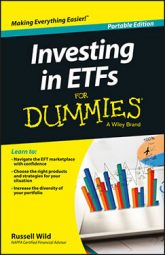If you have a portfolio of more than $20,000 and you are a buy-and-hold kind of guy or gal, break up your small cap holdings into a growth exchange-traded fund (ETF) and a value ETF. Given the dramatic outperformance of value in the past, you might tilt in that direction — more so than you do with large caps.
A reasonable tilt may call for somewhere between 60 and 75 of your small cap exposure going to value, and 25 to 40 percent going to growth.
If you have enough assets to warrant splitting up small value and small growth, go for it, by all means. Following are some good small growth options from iShares and Vanguard.
Vanguard Small Cap Growth ETF (VBK)
Indexed to: MSCI U.S. Small Cap Growth Index (approximately 970 small cap growth companies in the United States)
Expense ratio: 0.09 percent
Average cap size: $3.2 billion
P/E ratio: 27.3
Top five holdings: Alkermes PLC, Harman International, CMT Market Liquidity Rate, ISIS Pharmaceuticals, Cooper Companies
Russell's review: Add economy to wide diversification, tax efficiency beyond compare, and a very definite growth exposure, and I really have no complaints. The Vanguard Small Cap Growth ETF offers an excellent way to tap into this asset class. And that's especially true if you happen to hold your portfolio at Vanguard, where trading Vanguard ETFs incurs no commissions.
iShares Morningstar Small Growth Index ETF (JKK)
Indexed to: Approximately 370 companies from the Morningstar Small Growth Index
Expense ratio: 0.30 percent
Average cap size: $2.5 billion
P/E ratio: 31.5
Top five holdings: NorthStar Asset Management, Kate Spade & Co, DexCom Inc, Zebra Technologies, United Natural Foods
Russell's review: My only beef with the Morningstar indexes is that they tend to be a bit too concentrated, at least in the large cap arena. In their small caps, however, concentration isn't a problem. The largest holding here, NorthStar Asset Management, gets an acceptably small 0.9 percent allocation. The expense ratio, too, is acceptable, although higher than most others in this category. I like that Morningstar promises no crossover between growth and value. If you own this ETF along with the iShares Morningstar Small Value Index, you should get pleasantly limited correlation.
iShares S&P Small Cap 600 Growth ETF (IJT)
Indexed to: Despite the "600" in its name, this ETF tracks the 350 or so holdings that make up the S&P Small Cap 600/Citigroup Growth Index
Expense ratio: 0.25 percent
Average cap size: $1.8 billion
P/E ratio: 25.3
Top five holdings: Triguint Semiconductor, Maximus Inc, Toro Co, Buffalo Wild Wings Inc, Curtiss-Wright Corp.
Russell's review: S&P indexes are a bit too subjective for me to really love them. But this fund's price is reasonable, and there's no reason to snub this iShares offering. Apparently, Fidelity likes it because it allows you to buy and sell this ETF without paying any commission. (Of course, Fidelity gets some remuneration from iShares.)
Guggenheim S&P 600 Small Cap Pure Growth ETF (RZG)
Indexed to: Approximately 150 of the smallest and most growthy of the S&P 600 companies
Expense ratio: 0.35
Average cap size: $1.6 billion
P/E ratio: 23.9
Top five holdings: Lannett Co, Take-Two Interactive Software Inc, Carrizo Oil & Gas, Taser International, Synergy Resources Corp
Russell's review: The price is higher than others in this category, and the promise of "purity" is a bit murky — especially if the quest for purity leads to high turnover, which could reduce tax efficiency. Guggenheim also seems to cater mostly to traders rather than to buy-and-hold investors, and that makes me uncomfortable. Traders usually trade themselves into losses. All that being said, the fund's first five years of existence have seen pretty good performance: about 1 percent a year higher than the Russell 2000 (small cap) Growth Index. That's on a before-tax basis, however.

